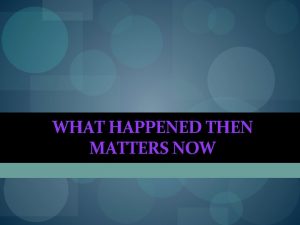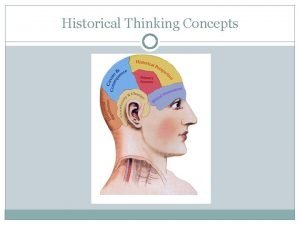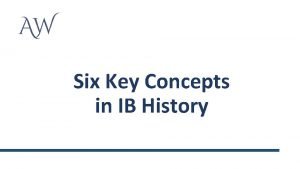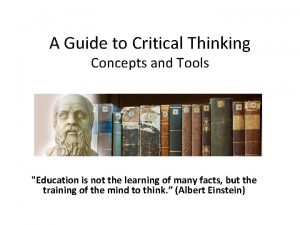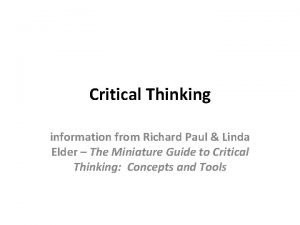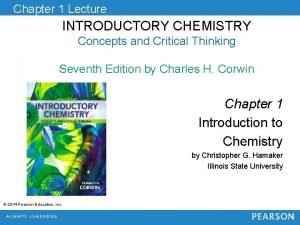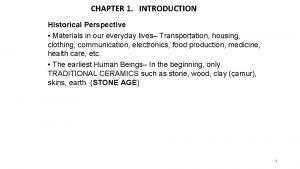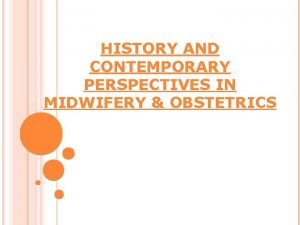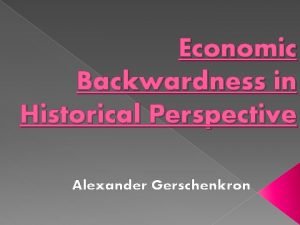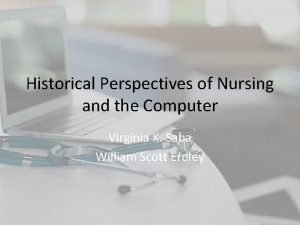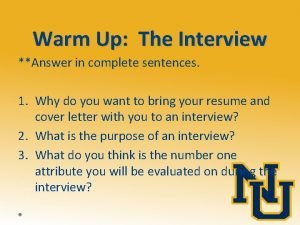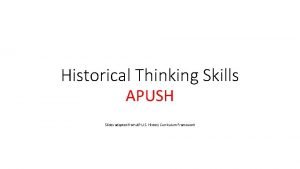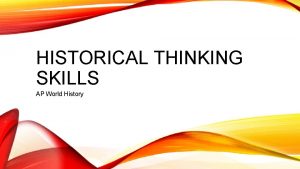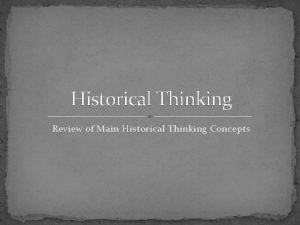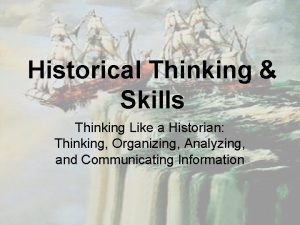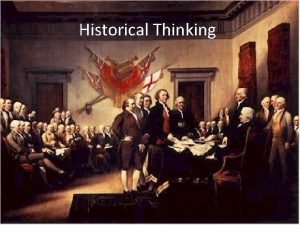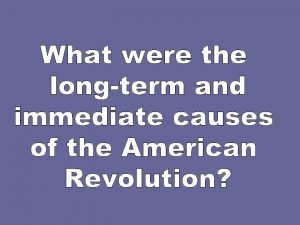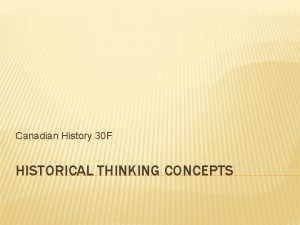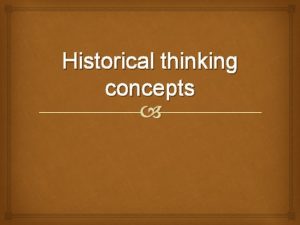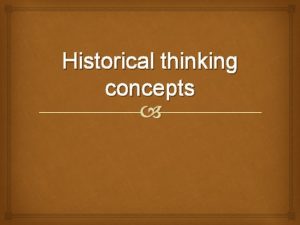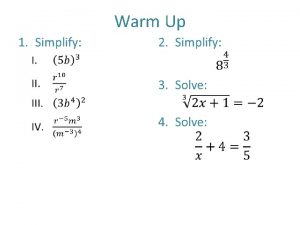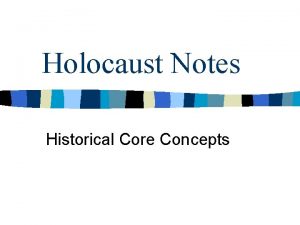Historical Perspective Historical Thinking Concepts Warm up Question


















- Slides: 18

Historical Perspective Historical Thinking Concepts

Warm up Question What do you think this quote means? “The past is a foreign country; they do things differently there”

TODAY’S PURPOSE Understand that… 1) There is often a huge difference between worldviews today and worldviews in the past. 2) When we take a historical perspective, we must be careful to avoid presentism. 3) People’s attitudes and worldviews are shaped by their historical context. 4) There are multiple perspectives among the groups of people involved in a given event.

Understanding Historical Perspectives Discussion Question: How would you feel if you sent a message to your family with important news and information about you, but you did not get a response from your family for 5 months?

Understanding Historical Perspectives Part 1: Read the following text and think about what it might have been like for people in the past to have to wait this long to receive a return message from their home country: “In 1858 people living in the British colony of Vancouver Island waited four to five months to receive a response to a letter sent from Victoria to London, England. This meant that important news from friends and family or advice and instructions from superiors took almost one-half year to receive. ” Write your answers in the space provided on your handout.

Historical Perspectives: Key Vocabulary • Historical perspective: Understanding an event from the perspective of the historical people or groups at the time, rather than from our modern perspective. • Presentism: assuming that the thoughts, feelings and attitudes of people or groups in the past were the same as our thoughts, feelings and attitudes in the present. History students should avoid this as much as possible.

Historical Perspectives: Key Vocabulary • For example, how can we know how people in 1858 would have felt about waiting 6 months to receive important information? • We need to understand the historical context in which they were living. Then we can make inferences about how they might have felt at the time.

Historical Context • Historical context refers to the political, economic, religious, social, intellectual, artistic and technological (or PERSIAT) conditions that existed during the time and place we are studying. • Political • Economic • Religious • Social • Intellectual • Artistic • Technological

Historical Context Let’s look at the technological context in 1858 compared to today: • Today, we are used to instant communication (texts, email, etc). But in 1858, sending letters was the fastest way to communicate over long distances. • People at the time would have understood this and would have expected long wait times between sending and receiving messages. Knowing some of the technological context in 1858, what can we now infer about the feelings of someone who finally received a letter from their home country that took 5 months to arrive? Use the space provided on your handout to write your answers.

Historical Perspective vs. Presentism Now write “Presentism” in the original box on your handout, and “Historical Perspective” in the new box. In history class, this is what we want! Try to understand people and events from the perspective of the people living at the time. In history class, we want to AVOID this! PRESENTISM HISTORICAL PERSPECTIVE

Historical Perspectives from the Future Knowing that people in the past would feel very differently about their lives than we do today, we can also imagine that people in the future might feel differently about the way we live today. Instructions: Imagine that people 100 years in the future all vegetarians, and that eating meat is viewed as animal cruelty. How would those future people view our society today? What would they need to do to avoid presentism? Write your answers using the space provided on your handout.

Understanding Multiple Perspectives What do you see? Duck or Rabbit? Another problem when trying to understand historical perspectives is that there is never just one perspective! Different people (or groups of people) can see or experience the exact same thing in very different ways!

Grease video: Same event, Multiple perspectives The boy and girl both telling the story of how they met in the summer. As you watch the video, think about the following questions. 1. What is similar about their stories? 2. What is different about their stories? 3. Why would he tell the story the way he did? 4. Why would she tell the story the way she did? 5. Who do you believe more? Why? 6. Does having multiple perspectives mean there is no truth? 7. What do we know definitely happened? 8. What is still up for debate?

Multiple Perspectives Activity Our future vegetarians have tried to understand our historical context, but they missed a very important detail: not everyone today feels the same way about eating meat! In other words, there are multiple perspectives on this issue all existing at the same time. Instructions: the class will be divided into four (4) groups, each with a different perspective. Your group will need to explain its perspective to the future vegetarians on the issue of meat eating today. Remember: you are explaining your position to someone who grew up in a society where it is unthinkable to eat meat! What will you tell them to help them understand your perspective?

The Least You Need to Know… Understand that… 1) There is often a huge difference between worldviews today and worldviews in the past. 2) When we take a historical perspective, we must be careful to avoid presentism. 3) People’s attitudes and worldviews are shaped by their historical context. 4) There are diverse perspectives among the groups of people involved in a given event.

Ethical Dimensions Historical Thinking Concepts

TODAY’S PURPOSE Understand that… 1) Moral/ethical evaluations of events that differ based on our moral guidelines. 2) Historians attempt to hold back on ethical judgments about people in the midst of their accounts, but, when all is said and done, if the story is meaningful, then there is an ethical judgment involved. 3) We should expect to learn something from the past that helps us to face the ethical issues of today.

Consider the Ethical Dimensions of History • If this event took place today, would people judge it differently? • What were the major values that existed during this time period that allowed this event to occur?
 Historical thinking concepts meaning
Historical thinking concepts meaning 4 historical thinking concepts
4 historical thinking concepts Costa level question
Costa level question Ib history key concepts
Ib history key concepts Victorian curriculum history
Victorian curriculum history Two point perspective box
Two point perspective box Silo perspective vs business process perspective
Silo perspective vs business process perspective Critical thinking concepts
Critical thinking concepts Paul elder model
Paul elder model Introductory chemistry concepts and critical thinking
Introductory chemistry concepts and critical thinking Materials in historical perspective
Materials in historical perspective Historical perspective of midwifery
Historical perspective of midwifery Gerschenkron economic backwardness
Gerschenkron economic backwardness State the history of community development
State the history of community development Historical perspective of nursing process
Historical perspective of nursing process Interview warm up
Interview warm up Apushslides
Apushslides Historical thinking skills ap world
Historical thinking skills ap world Positive thinking vs negative thinking examples
Positive thinking vs negative thinking examples
